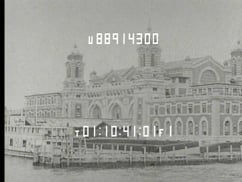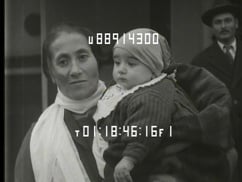



Archival footage offers a window into experiences from years past. The immigrant experience at Ellis Island was carefully documented by filmmakers, with some of the most notable footage dating back to 1903.
These scenes include a woman holding a child and waving an American flag, a man with two infants in a crowd of families posing for the camera, immigrants streaming off the boat at Ellis Island, and women staring at the Statue of Liberty.
Be on the lookout for these clips, which are often featured in documentaries about Ellis Island and European immigration. You might even spot a family member in the crowds; after all, about 30 percent of Americans can trace at least one ancestor through Ellis Island.
Imagine yourself stepping off the boat at Ellis Island, a pivotal milestone in your new life in America. Original footage of these first moments still exists and enables us to see the experience through the eyes of our ancestors. We’re grateful for access to the John E. Allen Archive, which features dozens of historic film clips, including ships arriving into the Port of New York, passengers stepping off a transport ferry with their luggage, and immigrants going through the inspection process before being officially accepted or denied entry into the United States.
Although this footage documents their first steps in the country, even more adjustment took place after disembarking the boats in New York Harbor. To learn more about who these immigrants were, take the opportunity to visit the exhibit Treasures From Home, located on the 3rd floor of the Ellis Island National Museum of Immigration. Here you can listen to people share their stories and view the precious keepsakes that they brought with them on their journey.
We hope this footage and exhibit provide some insight into the true immigrant experience at Ellis Island. If you are interested in searching for family members who travelled through the Port of New York (1820-1957), take advantage of our free passenger record database through the American Family Immigration History Center.
Images courtesy of John E. Allen, Inc.